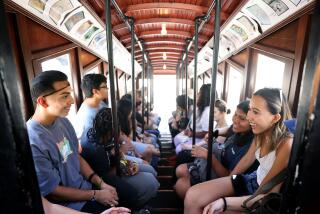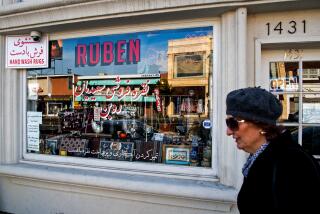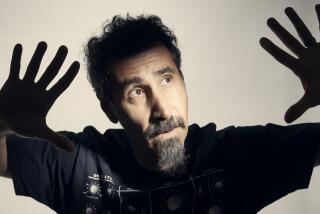Respecting Old-World Ways : Armenian School Puts Students in Touch With Their Roots
PICO RIVERA — When Principal David Ghoogasian enters classrooms, his students jump from their chairs and greet him in Armenian. In kindergarten, young sopranos sing him the Lord’s Prayer and then beg their teacher to allow them to dance. They do so in a circle to the wail of Old World music.
Respect for adults and reverence for tradition are not dying arts at the Armenian Mesrobian School in Pico Rivera, which has students from preschool to 12th grade.
Classes are steeped in Armenian history, literature and current events. The home economics course features instruction in Armenian cooking, including stuffed grape leaves, tabbouleh and baklava. Many of the classes are taught in Armenian. In gym, students master Armenian folk dancing.
This private school, a 28-year-old institution that enrolls 370 students, is an anchor for a community of Armenians living east of Los Angeles. The community’s traditions are rooted in both the school and the Holy Cross Armenian Apostolic Cathedral in Montebello. The school is affiliated with the church and run by a board of trustees of church and school officials.
“There’s a very enthusiastic attitude toward the school and the church because these are the institutions that keep the Armenians together,” said Archbishop Sumbat Lapajian. “They come to both for their culture and for their ethnic identity.”
Armenia, a Christian country north of Muslim Iran and east of predominantly Muslim Turkey, obtained its independence from the former Soviet Union in September, 1991. Many of the residents here view the struggling democracy as a continuation of a fight for survival that began in 1915 when Armenians were driven from their traditional homelands.
Although Turkish officials deny it, Armenians accuse the Turk regime of that period of a policy of genocide toward their people that resulted in more than 1 million deaths.
That history and the political events of the day are woven into the fabric of life for about 28,000 Armenians who live in Pico Rivera, Montebello and Whittier.
The area lists a cluster of names in the phone book that end in “ian” or “yan,” which is Armenian for “son of.” The cities are home to the Armenian Relief Society, an Armenian athletic club, a political club and a group for the youth.
But the school remains the nucleus of the community.
It is certified to teach college preparatory courses, and more than 90% of its students pursue higher education. The teachers say they have been successful in keeping their culture alive by emphasizing history. When their homeland had no government of its own, the people filled the vacuum by maintaining their faith and their language in the churches and schools around the world, Ghoogasian said.
“When you have people who are trying to do you in as a race, you do stick together,” he said.
Ghoogasian, 28, calls himself one of the school’s “lifers.” Like a few other teachers, Ghoogasian began attending the school at age 4, studied there until graduation, then returned after college to teach and finally to serve as its principal.
Since his days as a student, the school’s focus has changed somewhat, Ghoogasian said. Then, he said, the school aimed simply to keep the culture alive. However, since Armenia obtained its independence, the students today are more driven to aid the country’s struggling democracy.
“I want to use what I’ve learned here to help the cause,” said Jeffrey-Gevork Najarian, a 17-year-old who plays on the school’s baseball team and is a member of its student government.
Najarian is not alone.
Last winter, Armenia became increasingly mired in an undeclared, five-year war with Azerbaijan over Nagorno-Karabakh, a mountainous enclave populated mainly by ethnic Armenians but located inside Azerbaijan. The school’s students joined Armenians throughout Southern California in sending clothes and canned goods as part of a national project known as Operation Winter Rescue.
In March, the girls in the cooking class raised $400 for war refugees by selling the baklava and other food they had prepared. The sixth-graders helped buy a ton of bulgur, a cracked wheat used in many Armenian dishes, for the struggling country.
This summer, several of the students are planning to visit the country to help with restoration projects. Those who have done so in the past praise the experience.
Armen Dikranian, a 19-year-old premed student at USC, spent last July in a mountainous northeastern Armenian village helping restore churches built in the 15th Century.
Dikranian, who had been an altar boy at the Montebello church, participated in an Armenian youth group. He had expected his church experiences and his 12 years at the Armenian school to help him fit in when he arrived in Armenia. But book smarts had its limits.
“It was still a culture shock,” Dikranian said. “I hadn’t expected to see the poverty.” Two hundred families lived in the village, and Dikranian said they ate potatoes with baked bread and cheese every day. They had little variety in food, he said, but they shared openly.
“We were welcomed as Armenians,” Dikranian said.
While Dikranian and several other students feel loyalty to both their Armenian and their American ancestry, they said the school has given them an appreciation of their parents’ culture at a time when many of their peers are unable to trace their ethnic backgrounds.
“It’s hard to keep people interested in their culture in America,” Dikranian said. “People feel like they have to fit in.”
The school is not exclusive to Armenians. Six of the 31 teachers are not Armenian. Eleven of the 370 students also are not of Armenian descent, although the school still requires those students to take Armenian as a second language.
Rosalie Elder and her husband, a retired police chief from Monterey Park, enrolled their 13-year-old daughter at the school when she was 3 because the school offered a full-time preschool program. But the couple, a third-generation Irish woman and a man with a mixture of English, Irish and German roots, soon came to appreciate the skills their daughter learned from the Armenians.
“I didn’t want her to grow up thinking everybody was exactly the same, exactly like we were,” said Rosalie Elder. “She is now very articulate. She reads and writes very well in both languages. And she doesn’t have the typical mind-set of a 13-year-old who says, ‘Now I have to go to high school and learn a different language.’ ”
Classes taught in Armenian, including history and current events, help keep the students connected to the homeland.
“If you can’t communicate in your grandmother’s language, that culture won’t be passed to you,” Ghoogasian said. “Language is a bridge to that time.’
More to Read
Sign up for Essential California
The most important California stories and recommendations in your inbox every morning.
You may occasionally receive promotional content from the Los Angeles Times.










